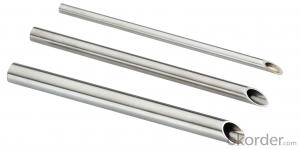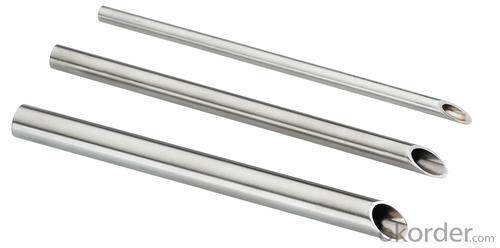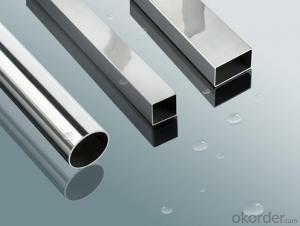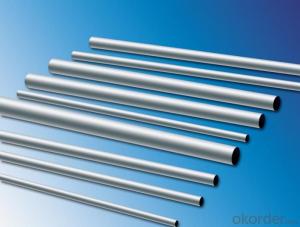Stainless Steel Sheet for Standard 200,300,400 Series
- Loading Port:
- Shanghai
- Payment Terms:
- TT OR LC
- Min Order Qty:
- 1000 kg
- Supply Capability:
- 10000 kg/month
OKorder Service Pledge
OKorder Financial Service
You Might Also Like
Packaging Detail: | Bundle or Container or as per customers requirement. |
Delivery Detail: | within 25 days after we receive an irrevocable L/Cor 30% deposit |
ASTM A335 Seamless Alloy-Steel Pipe
Standard: BS 1139, BS 3059-2, JIS G3454-2007
Grade: 10#-45#, 15NiCuMoNb5, 10Cr9Mo1VNb
Detailed introduction to ASTM A335 seamless alloy steel pipe:
ASTM A335 seamless alloy steel pipe
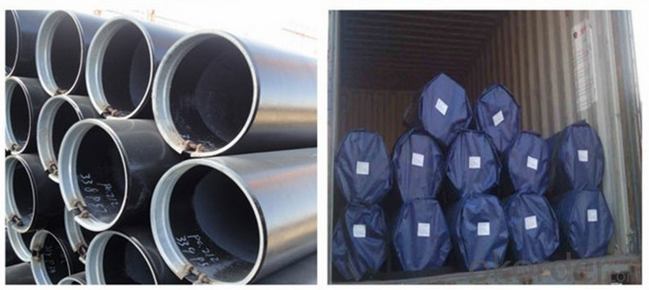
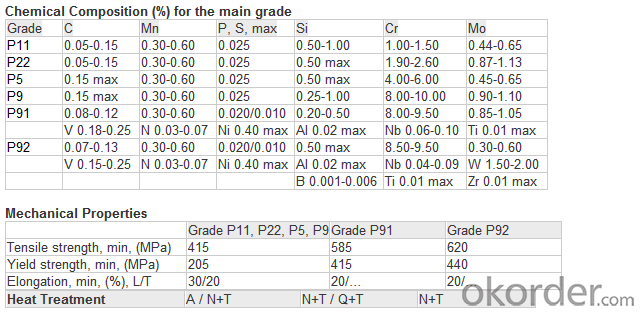
FAQ:
1) why you chose us ?
Professional Manufacturer and supplier of Steel pipe
More than 14 years’ professional producing experience
We can get the lowest ex-factory prices. The price are quite reasonable and it is lower than our commercial peers. also, we can guarantee the qualities of our products.
BV, ISO certificates and SGS test can be provided to assure the quality of our products.
2) Our minimum order quantity:
10 Metric Tons or one 20ft or 40ft Container.
3) How about the Delivery Time?
The steel pipe will be produced since we getting your deposit by T/T or Your original L/C. For normal size, some stocks in our factory now, we can supply once you need.
4)What kind of payment does your company support?
T/T, 100% L/C at sight, Cash, Western Union are all accepted.
5) Do you charge for the samples?
According to our company principle, we just charge for samples, you pay for the freight /courier charge.
6) Main market:
Mid East, South America, Africa, Southeast Asia, India etc
- Q:304 stainless steel seamless tube weight how to calculate?
- 304 stainless steel is a common stainless steel material, the density of 7.93 g/cm3, the industry is also called 18/8 stainless steel. High temperature resistance of 800 degrees, with good processability, high toughness characteristics, widely used in industry and furniture decoration industry and food and medical industry.
- Q:How do you calculate the weight of a stainless steel pipe?
- To calculate the weight of a stainless steel pipe, you would need to know the outer diameter, wall thickness, and length of the pipe. You can then use the formula: Weight = (Outer Diameter - Wall Thickness) x Wall Thickness x Length x Density of stainless steel.
- Q:Are stainless steel pipes suitable for beer brewing applications?
- Yes, stainless steel pipes are highly suitable for beer brewing applications. Stainless steel is a popular choice in the brewing industry due to its excellent corrosion resistance, durability, and hygiene properties. The smooth surfaces of stainless steel pipes prevent the buildup of bacteria, yeast, and other contaminants, ensuring a clean and safe brewing environment. Stainless steel pipes also have high temperature resistance, which is essential for various brewing processes such as boiling and sterilization. Additionally, stainless steel is an inert material, meaning it does not react with the beer, preserving the taste and quality of the final product. Overall, stainless steel pipes provide the necessary qualities for beer brewing applications and are widely used in the industry.
- Q:Can stainless steel pipes be insulated with polyamide?
- Indeed, polyamide is a suitable material for insulating stainless steel pipes. Renowned for its remarkable insulation properties, polyamide is a plastic substance that can be utilized as either a coating or lining for stainless steel pipes. By employing polyamide insulation, the pipes become shielded against extreme temperatures, be it hot or cold. This insulation is of utmost importance as it prevents heat loss or gain, a crucial factor in maintaining the desired temperature of fluids or gases flowing through the pipes. Moreover, in addition to its insulation capabilities, polyamide also acts as a safeguard against corrosion and mechanical harm, thereby amplifying the longevity and resilience of the stainless steel pipes.
- Q:What is the difference between seamless and high-frequency welded stainless steel pipes?
- Seamless and high-frequency welded stainless steel pipes are two different types of pipes used in various applications. Seamless stainless steel pipes are manufactured through a process called seamless pipe manufacturing, where a solid billet is heated and pierced to form a hollow tube. This process ensures that there are no seams or joints in the pipe, making it ideal for applications that require high pressure, high temperature, or corrosive environments. Seamless pipes offer superior strength and reliability due to their uniform composition and absence of welding. On the other hand, high-frequency welded stainless steel pipes are manufactured using a different process known as high-frequency welding. This process involves passing a flat strip of stainless steel through a series of rollers to form a tube shape. The edges of the strip are then heated using high-frequency electrical currents and fused together to create a solid pipe. The resulting pipe has a visible welded seam along its length. While both seamless and high-frequency welded stainless steel pipes are made from stainless steel, there are some differences between them. One major difference is the manufacturing process. Seamless pipes are made without any welding, resulting in a pipe with no seams or joints. High-frequency welded pipes, on the other hand, have a visible welded seam along their length. Another difference is in their strength and reliability. Seamless pipes have a more uniform composition and absence of welding, which gives them higher strength and reliability compared to high-frequency welded pipes. This makes seamless pipes more suitable for applications that require high pressure, high temperature, or corrosive environments. Additionally, the production cost of seamless pipes is generally higher than that of high-frequency welded pipes. The seamless pipe manufacturing process requires more complex machinery and additional steps, leading to higher production costs. High-frequency welded pipes, on the other hand, involve a simpler and more cost-effective manufacturing process. In summary, the main difference between seamless and high-frequency welded stainless steel pipes lies in their manufacturing process, strength, and cost. Seamless pipes are made without any welding, offering higher strength and reliability, but at a higher cost. High-frequency welded pipes have a visible welded seam but are more cost-effective. The choice between the two types of pipes depends on the specific requirements of the application and the budget available.
- Q:How do you calculate the expansion of stainless steel pipes?
- In order to calculate the expansion of stainless steel pipes, it is necessary to take into account the coefficient of thermal expansion (CTE) of the material. The CTE quantifies the extent to which a material expands or contracts when exposed to temperature changes. To begin, the initial length of the stainless steel pipe must be determined. This refers to the length of the pipe at the starting temperature. Subsequently, the final operating temperature of the pipe needs to be established. This denotes the temperature at which the expansion is desired to be calculated. The CTE value for the specific grade of stainless steel used in the pipe must be obtained. The CTE is typically expressed in units of per degree Celsius (or per degree Fahrenheit). Multiply the initial length of the pipe by the CTE value and then multiply it by the change in temperature. This computation yields the expansion or contraction of the pipe within the given temperature range. For instance, assume a stainless steel pipe with an initial length of 10 meters, a CTE of 17 x 10^-6 per degree Celsius, and a desired expansion calculation at a final temperature of 100 degrees Celsius. The change in temperature is determined by subtracting the initial temperature from the final temperature. Expansion = Initial Length * CTE * Change in Temperature Expansion = 10 meters * 17 x 10^-6 per degree Celsius * 100 degrees Celsius Expansion = 0.0017 meters or 1.7 millimeters Consequently, when subjected to a temperature increase of 100 degrees Celsius, the stainless steel pipe would expand by 1.7 millimeters. It is important to note that this calculation assumes a uniform expansion throughout the entire length of the pipe. In reality, thermal expansion may vary due to factors such as pipe diameter, wall thickness, and other structural considerations. Thus, it is advisable to consult industry standards or engineering references for more precise calculations in specific applications.
- Q:Can stainless steel pipes be fabricated?
- Yes, stainless steel pipes can be fabricated.
- Q:Can stainless steel pipes be used for agricultural irrigation systems?
- Yes, stainless steel pipes can be used for agricultural irrigation systems. Stainless steel is known for its durability, corrosion resistance, and ability to withstand harsh environmental conditions, making it a suitable choice for agricultural applications where long-term performance is required.
- Q:Can stainless steel pipes be used for brewery and beverage industry applications?
- Stainless steel pipes are suitable for use in brewery and beverage industry applications. This material is renowned for its exceptional corrosion resistance and hygienic properties, making it an ideal option for these sectors. The presence of high levels of chromium and nickel in stainless steel pipes provides excellent protection against corrosion caused by chemicals, acids, and high temperatures. Moreover, stainless steel pipes are easy to clean and maintain, ensuring the highest level of hygiene required in brewery and beverage production. The smooth inner surface of these pipes also reduces the risk of contamination and bacterial growth, making them even more suitable for these applications. In summary, stainless steel pipes offer durability, reliability, and sanitary features that make them the preferred choice for the brewery and beverage industry.
- Q:Can stainless steel pipes be insulated with neoprene?
- Neoprene insulation is capable of being applied to stainless steel pipes. Neoprene, a highly adaptable and long-lasting material renowned for its exceptional insulation qualities, is frequently employed to insulate a variety of pipe types, including stainless steel. Neoprene insulation can successfully lessen heat loss or gain, avert condensation, and furnish defense against extreme temperatures. Additionally, it possesses resistance to moisture, chemicals, and UV radiation, rendering it an appropriate choice for a diverse array of applications. Correct installation of neoprene insulation can effectively heighten the energy efficiency and performance of stainless steel pipes.
1. Manufacturer Overview |
|
|---|---|
| Location | |
| Year Established | |
| Annual Output Value | |
| Main Markets | |
| Company Certifications | |
2. Manufacturer Certificates |
|
|---|---|
| a) Certification Name | |
| Range | |
| Reference | |
| Validity Period | |
3. Manufacturer Capability |
|
|---|---|
| a)Trade Capacity | |
| Nearest Port | |
| Export Percentage | |
| No.of Employees in Trade Department | |
| Language Spoken: | |
| b)Factory Information | |
| Factory Size: | |
| No. of Production Lines | |
| Contract Manufacturing | |
| Product Price Range | |
Send your message to us
Stainless Steel Sheet for Standard 200,300,400 Series
- Loading Port:
- Shanghai
- Payment Terms:
- TT OR LC
- Min Order Qty:
- 1000 kg
- Supply Capability:
- 10000 kg/month
OKorder Service Pledge
OKorder Financial Service
Similar products
New products
Hot products
Hot Searches
Related keywords
